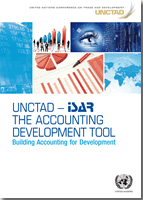
Convergence towards international standards for consistent and reliable corporate reporting contributes to creating a conducive investment climate and financial stability.
The Accounting Development Tool (ADT), developed by UNCTAD Intergovernmental Working Group of Experts on International Standards of Accounting and Reporting (ISAR), addresses the request from member States for guidance on how to facilitate such convergence.
Built on international consensus, the ADT has been designed and developed as a voluntary technical aid to support countries’ efforts towards building capacities in the domains of corporate reporting based on a guided selfassessment methodology and consensus-building among key stakeholders.
The ADT uses a comprehensive and structured approach to identify and assess the legal, institutional and human resource requirements needed for a strong accounting and reporting infrastructure.
The overall objective of the ADT is to assist policymakers and other stakeholders in their efforts towards strengthening the accounting and reporting infrastructure for high-quality and internationally comparable corporate reporting.
The ADT provides an approach, the methodology and instruments for quantitative measurement of existing reporting infrastructure at a national level in order to identify gaps when compared to international standards and good practices. It can also serve as a basis for developing a strategy and an action plan for further improvements of corporate reporting based on the gaps identified and selected priority areas. Where relevant, the ADT can also help to assess country needs for technical assistance and to measure the impact of such assistance.
The United Nations Conference on Trade and Development stands ready to support interested countries throughout the assessment process by providing additional expertise.
The objective of this publication is to provide guidance on the concept behind and content and practical application of the ADT. It consolidates the discussions, insights and experience gained throughout the many development phases of the tool.
Part I of the publication explains what the ADT is by describing its conceptual foundation, context, content, relevance, purpose and scope, as well as its components, structure and measurement methodology.
Part II explains how to use the ADT by providing a concrete, step-by-step guide, with all the necessary information about the tasks, actions and stakeholders involved in the ADT application and detailed instructions on how to use the e-ADT platform (the online version of the ADT).
Countries that participated in the pilot tests in 2011–2013 have emphasized the practical usefulness of the ADT and its important role in better understanding priorities and actions needed to build a strong corporate reporting infrastructure and in creating a participatory and constructive dialogue among key stakeholders.
We hope that this publication will help member States in their efforts towards high-quality and internationally comparable reporting and in assessing their progress over time in this area, which is important to facilitate investment and sustainable development.



